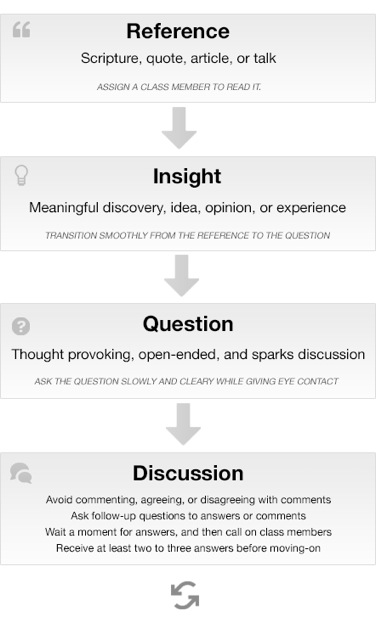How To Teach A Lesson
There is an old saying within the Church: “Teaching: No Greater Call!” Yet how to effectively teach is a hard lesson to come by. Few members called into teaching position exercise effective skills in conducting a discussion, nor do they ask inviting questions that promote ideas and thoughts. The most effective way to engage in a learning environment is to stretch one’s comfort zone and challenge existing assumptions. However, this often introduces fear and hesitation into the teachers’ and students’ space and therefore restricts their actions.
This is a suggested format for how to engage students in a classroom setting. This is also applicable for missionary lessons and Family Home Evening lessons. The definition of teaching is to delegate learning to the student. Learning is the process of self-discovery.
- Use the outlines for inspiration, but don’t rely too heavily on the LDS.org‘s outlines. Compose your own outline suited to your interests and strengths.
- It is not your job to do the talking or simply fill time. This is not a lecture; in fact the less you talk the better. It is far better to end class early than to ramble on. A mark of a good teacher can be measured by two things:
- thought provoking questions
- students speak more than the teacher
- Questions are at the center of any effective lesson. Every reference or question should inspire and encourage dialog among the students.
- Deliver your question while giving eye contact, try not to read it (speak slowly and clearly).
- Ask open ended questions. Only ask close ended questions (Yes or No) if followed by an open ended question?
- Prepare different ways to ask the same question – this helps you develop the right way to ask it so as to inspire dialogue and students differ in their listening and learning styles.
- Do not answer your own question(s). Don’t give your opinion or comment on your own question, that teaches the class not to think. Pause for a few moments before calling on student’s if you get no response.
- Use silence as a teaching tool. It is golden unless you fear it. Use their discomfort to smile and invite their thoughts with your eyes and body language, not your words.
- Don’t comment on other peoples’ answers unless you are clarifying or asking a follow up question.
- Consider challenging any student’s answer if it’s not thought-out or is too basic. A simple follow up question to a short and simple answer might be ‘What do you mean?’
- Challenge assumptions (neutrally), especially those who articulate their points of view, whether you as the teacher agree or not.
- To challenge means to ask for clarity: “Can you elaborate?” “How did you get to that position?” or “What other ways are there to see that position?”
- Ask questions by building on a student’s answer.
- Ask a question on your own about something related to the material or topic at hand.
- Explain to the class at the start of the lesson your expectations (or “Rules of Engagement”) for the class. They might include:
- You are expected to think deeply (‘think like a Hebrew’ vs. a ‘Greek’. Hebrews think holistic, in metaphors, Greeks think sequential, concrete.)
- The process of learning is when we question our own assumptions.
- Participants in class add to the learning environment by asking good questions and giving brief insightful or personal answers. However, it is harmful when participants monopolize class time and tell long personal stories. Such behavior drives away the Spirit and minimizes class participation.
- Let the class have the power to discuss related topics.
- The teacher is in control of the direction. If the conversation goes in a different direction than the outline and the Spirit is present, let it go.
- Resist the urge to constantly inject your own thoughts or experiences into the class conversation.
- Remember you are the conductor not the lead singer. Listen to the Spirit to know what questions you could ask about the different topics, stories, or answers that are shared.
- If a student raises a question, encourage someone else to answer (it’s not always your place to answer questions, that’s the classmates responsibility).


Thank you, again for these principles. It will come into play with a new class next week in S.S. I have a lot of improving to do!